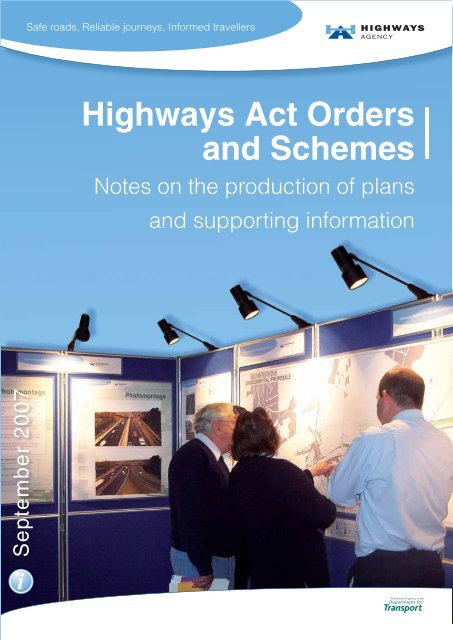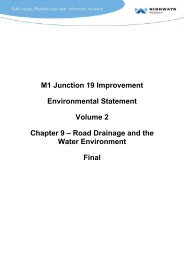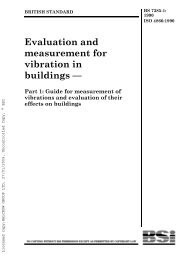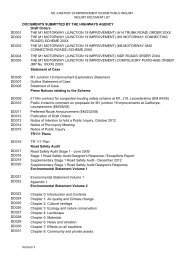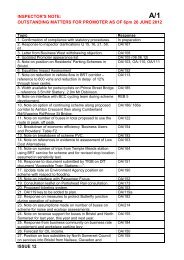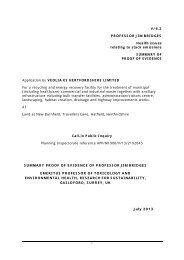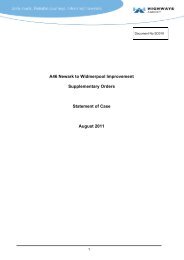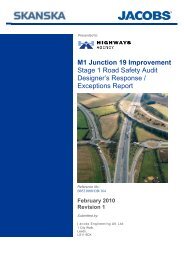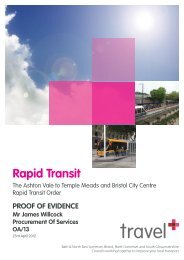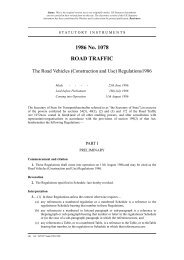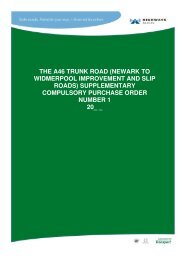Highways Act Orders and Schemes
Highways Act Orders and Schemes
Highways Act Orders and Schemes
Create successful ePaper yourself
Turn your PDF publications into a flip-book with our unique Google optimized e-Paper software.
Safe roads, Reliable journeys, Informed travellers<br />
<strong>Highways</strong> <strong>Act</strong> <strong>Orders</strong><br />
<strong>and</strong> <strong>Schemes</strong><br />
Notes on the production of plans<br />
<strong>and</strong> supporting information<br />
September 2007<br />
i<br />
An Executive Agency of the
Index<br />
Introduction<br />
2<br />
Section A: Plans<br />
5<br />
1. General<br />
2. Line, detrunking <strong>and</strong> trunking <strong>Orders</strong> under Section<br />
10 of the <strong>Highways</strong> <strong>Act</strong> 1980<br />
3. <strong>Schemes</strong> under Section 16 of the <strong>Highways</strong> <strong>Act</strong> 1980<br />
4. Appropriation <strong>and</strong> Transfer <strong>Orders</strong> under Section 18<br />
of the <strong>Highways</strong> <strong>Act</strong> 1980<br />
5. Side Roads <strong>Orders</strong> (SRO) under Section 14 or 18<br />
of the <strong>Highways</strong> <strong>Act</strong> 1980 <strong>and</strong> stopping up of PMA<br />
under Section 124 of the <strong>Highways</strong> <strong>Act</strong> 1980<br />
6. Bridges over Navigable Waters <strong>and</strong> Diversion of<br />
Navigable Waters<br />
5<br />
8<br />
13<br />
16<br />
18<br />
24<br />
Section B: Supporting Information<br />
25
These notes provide guidance on the preferred method for<br />
preparing statutory Order plans <strong>and</strong> *Scheme plans, <strong>and</strong><br />
associated information.<br />
Introduction<br />
1. Statutory <strong>Orders</strong>/<strong>Schemes</strong>, with associated schedules <strong>and</strong> plans, are the primary<br />
documents which give legal powers, when made, to the Secretary of State to<br />
construct road improvement schemes. Each Order is accompanied by plans, which<br />
are required to provide clarity <strong>and</strong> remove ambiguity. The principal aim must be to<br />
ensure that <strong>Orders</strong> are legally sound <strong>and</strong> provide the powers necessary to deliver<br />
our schemes. The <strong>Orders</strong> should provide the greatest clarity to those affected by<br />
our proposals without compromising the legal position in any way.<br />
2. Once the need for <strong>Orders</strong> is identified the <strong>Highways</strong> Agency will ask the Consultant<br />
or the Contractors Design Team to prepare the basic documentation (ORD forms,<br />
plans <strong>and</strong> in some cases, schedules) to enable the <strong>Orders</strong> to be put together.<br />
3. When preparing <strong>Orders</strong>, our aim should be to make the minimum changes to<br />
the highway network needed to deliver the scheme, including any mitigation<br />
measures (which will be detailed in the Environmental Statement).<br />
Types of <strong>Orders</strong><br />
4. The following are the powers which are available for production of <strong>Orders</strong>. They<br />
dictate what may be included in any particular Order. Normally the Agency will<br />
identify which <strong>Orders</strong> are needed. However, if it becomes clear that additional<br />
<strong>Orders</strong> may be needed then this should be flagged up with the Project Manager.<br />
<strong>Orders</strong> under Section 10 of the <strong>Highways</strong> <strong>Act</strong> 1980<br />
5. Section 10 of the <strong>Highways</strong> <strong>Act</strong> creates a new Section of trunk road or trunks or<br />
detrunks an existing road. When a road is being detrunked the Order can include<br />
the future classification of the road.<br />
* The statutory term for a motorway is a special road, <strong>and</strong> an Order for a motorway is called a Scheme
<strong>Orders</strong> under Section 14 of the <strong>Highways</strong> <strong>Act</strong> 1980<br />
6. Section 14 of the <strong>Highways</strong> <strong>Act</strong> can allow the improvement of existing highway,<br />
the creation of new highway or the stopping up of existing highway. It is used to<br />
take powers to improve or to create new local authority highways or to stop up any<br />
highway including trunk road <strong>and</strong> is used in association with trunk road works. For<br />
motorway projects Section 18 powers are used. An Order under Section 14 can<br />
also include the creation of a temporary highway which will normally be maintained<br />
by the Agency rather than a local authority.<br />
7. An Order under Section 14 can also stop up or create a private means of access.<br />
Where only an access is affected an Order under Section 124 may be more<br />
appropriate.<br />
<strong>Schemes</strong> under Section 16 of the <strong>Highways</strong> <strong>Act</strong> 1980<br />
8. Section 16 of the <strong>Highways</strong> act allows for the creation of a new length of motorway<br />
for which the Agency will be the highway authority.<br />
<strong>Orders</strong> under Section 18 of the <strong>Highways</strong> <strong>Act</strong> 1980<br />
9. Section 18 of the <strong>Highways</strong> <strong>Act</strong> can allow the improvement of existing highway,<br />
the creation of new highway or the stopping up of existing highway. It is used to<br />
take powers to improve or to create new local authority highways or to stop up any<br />
highway including trunk road <strong>and</strong> is used in association with motorway projects.<br />
For trunk road projects Section 14 powers are used. An Order under Section<br />
18 can also include the creation of a temporary highway which will normally be<br />
maintained by the Agency rather than a local authority. An Order under Section 18<br />
can also stop up or create a private means of access.<br />
10. Section 18 can also allow the conversion of existing all purpose trunk road or a<br />
local authority road to a motorway. This Order would be separate from an Order<br />
under Section 18 altering highways or accesses.<br />
Section 106 of the <strong>Highways</strong> <strong>Act</strong> 1980<br />
11. Section 106 allows the construction of a bridge over or a tunnel under navigable<br />
waters. This can be done either by an Order under Section 106 or by including the<br />
proposal within an Order under Section 10, 14 or 18 or a Scheme under Section 16.
Section 108 of the <strong>Highways</strong> <strong>Act</strong> 1980<br />
12. Section 108 allows the diversion of navigable waters where this is necessary for<br />
the construction or improvement of any highway or the stopping up or creation of<br />
a means of access. The power can be included in an Order under Section 14 or<br />
Section 18.
Section A - Plans<br />
Style <strong>and</strong> format of Order plans vary depending on the type of Order <strong>and</strong> the size <strong>and</strong><br />
complexity of the scheme. The following guidance applies generally. Where a particular<br />
style is adopted by the project team it should be used consistently throughout.<br />
1. General to all Plans<br />
1.1 The plans should be on Ordnance Survey base <strong>and</strong> should include a Crown<br />
Copyright box. Crown Copyright should be recorded by the words<br />
“This plan is based upon Ordnance Survey material with the permission of Ordnance<br />
Survey on behalf of the controller of Her Majesty’s Stationery Office © Crown<br />
copyright. Unauthorised reproduction infringes Crown copyright <strong>and</strong> may lead to<br />
prosecution or civil proceedings. <strong>Highways</strong> Agency 100018928 20..”<br />
(insert current year)<br />
1.2 Plans should include a north arrow: there is no requirement that north should be<br />
at the top of the plan. Where there are a number of site plans/sheets to a plan, or a<br />
number of <strong>Orders</strong>, as far as possible, the plans should all have a similar orientation.<br />
1.3 Plans should normally include the name of the County, Borough or District, <strong>and</strong><br />
Parish or Town in whose area they lie. They should normally feature all road<br />
numbers, road names <strong>and</strong> all other names (eg place names, street names,<br />
house names & numbers etc) that are referred to in the <strong>Orders</strong>, Schedules <strong>and</strong><br />
Explanatory Statements. Where reference is made to a location some distance<br />
from the scheme, to avoid the need to enlarge the map so that it becomes difficult<br />
to h<strong>and</strong>le, the name should be marked at the edge of the plan with an arrow<br />
indicating the direction to that location.<br />
1.4 The following information should be included either on the plan or on the folio cover<br />
if a folio is included:<br />
• A scale both linear <strong>and</strong> in words. Guidance on recording the scale of<br />
insets is given below.<br />
• A box for the signature of the Order<br />
• The title. In addition, the sheets of the Order must be numbered <strong>and</strong>/or<br />
named. Guidance on this is given in the Sections below.<br />
• A key
1.5 When the preparation of draft Order plans is started, a plan register number<br />
should be requested for each Order <strong>and</strong> recorded on the plan or folio cover.<br />
The Special Road <strong>Schemes</strong> <strong>and</strong> <strong>Highways</strong> <strong>Orders</strong> (Procedure)<br />
Regulations 1993 SI 169<br />
1.6 These Regulations impose specific requirements on certain types of Order.<br />
The requirements, which are identified in the individual Sections below,<br />
should be complied with in all cases.<br />
Notes<br />
1.7 Notes can be included on plans to provide clarity. The notes for each type of<br />
plan are described in the individual Sections below.<br />
Use of Plan Folios<br />
1.8 Where there are two or more site plans/sheets for an Order these should be<br />
bound together in a plan folio. The folio cover should comprise the Order<br />
title, key, scale(s), signing block <strong>and</strong> plan registry number. For single sheet<br />
schemes this information is normally recorded on the plan <strong>and</strong> a folio sheet<br />
is unnecessary. The bound folio will normally be A4 in size <strong>and</strong> therefore, the<br />
folio cover should be A4 <strong>and</strong> the final Order plans need to be designed to fold<br />
to that size.<br />
Use of Key Plans <strong>and</strong> Location Plans<br />
1.9 When an Order plan contains more than one site plan/sheet, a Key Plan<br />
should be included showing the boundary of each of the site plans. The key<br />
plan should be at a scale appropriate to the size of the scheme <strong>and</strong> may be<br />
as small as 1:50,000. For very large schemes, the key plan may need to be<br />
shown on more than one sheet. Key plans should be marked KEY PLAN in the<br />
top or bottom right h<strong>and</strong> corner. Where there is more than one key plan sheet,<br />
each should be numbered (Key Plan 1 of 3, 2 of 3 etc).<br />
1.10 Occasionally, where only one site plan is needed a Location Plan will be<br />
included to show where the scheme is. This should follow a similar style to the<br />
key plan <strong>and</strong> should be labelled ‘Location Plan’. If there is no folio, the location<br />
plan should be included on the same sheet as the Order plan.
Scale of Plans<br />
1.11 The guidance below gives details of the scales applicable for particular types<br />
of Order. The choice of scale, particularly for major schemes, will normally be a<br />
compromise. Larger scale plans allow more information to be shown <strong>and</strong> are<br />
essential if a lot of complex detail needs to be conveyed. However, it is easier to<br />
gain an overall picture of the scheme at a smaller scale. Where the bulk of the<br />
proposals can be understood from a smaller scale plan, particular items which<br />
require more detail can be shown on insets. On major schemes, the smaller scale<br />
used for the Special Road Scheme or Trunk Road line Order acts as an overview<br />
with greater detail shown in the Side Roads Order. For smaller schemes, there are<br />
benefits in using the same scale for all the plans, including l<strong>and</strong> reference plans<br />
<strong>and</strong> Compulsory Purchase Order plans to allow them to be compared <strong>and</strong> read<br />
between easily.<br />
Use of Insets<br />
1.12 You can use insets to make plans less cumbersome <strong>and</strong> more importantly easier<br />
for users to underst<strong>and</strong>. Insets are more likely to be used on Side Roads Order<br />
plans. They can be used to show enlarged detail, <strong>and</strong> generally to provide<br />
greater clarity. Insets also enable different markings that coincide (eg, *PMA to<br />
be stopped up <strong>and</strong> route of new PMA, highway to be stopped <strong>and</strong> route of new<br />
or improved highway) to be shown separately.<br />
1.13 Insets should be labelled INSET. If there is more than one inset on a page, each<br />
inset should be labelled INSET A, INSET B etc moving from left to right across<br />
the plan. Care should be taken to ensure that the area outlined on the main plan<br />
corresponding to the inset (i) matches the area shown on the inset <strong>and</strong> (ii) is<br />
labelled SEE INSET A etc. Where all the insets are at the same scale as the main<br />
plan there is no need to include a separate scale for the insets. But if the insets<br />
are at a different scale, this should be shown within the inset.<br />
* PMA = private means of access
2. Line, Detrunking <strong>and</strong> Trunking <strong>Orders</strong> under Section<br />
10 of the <strong>Highways</strong> <strong>Act</strong><br />
Extent of Plans<br />
Requirement of Regulations<br />
2.1 The requirements of the Regulations are that the detail must be shown for at least<br />
67 metres to either side of the centre line of a new road shown in the Order. This<br />
includes 67 metres from any new connecting roads (i.e. slip roads). The base<br />
map must be Ordnance Survey based <strong>and</strong> show up-to-date detail.<br />
Scale<br />
Requirement of Regulations<br />
2.2 The Regulations require any Order plan for a new trunk road line to be at a scale<br />
of not less than 1:10,000.<br />
2.3 For a large scheme, 1:10,000 will normally be appropriate. For small schemes, a<br />
larger scale should be considered, eg 1:5,000 or 1:2,500.<br />
2.4 Trunking an existing non-trunk road <strong>and</strong> detrunking are not subject to the<br />
Regulations. As the highway is already in existence, a small scale plan may be<br />
appropriate but this should not be less than 1:50,000. If trunking/detrunking<br />
<strong>Orders</strong> are being published as part of a project including a new trunk road line<br />
or motorway scheme, the trunking <strong>and</strong> detrunking plans should be at the same<br />
scale as those for the new road.<br />
2.5 Where a small scale is used for the plan, <strong>and</strong> there are one or two items which<br />
need to be at a larger scale, for example termination points for the trunking or<br />
detrunking, this can be done by using insets.<br />
Markings<br />
Requirement of Regulations<br />
2.6 That the new centre line be shown by a solid black line not more than<br />
1.5 mm wide.
St<strong>and</strong>ard Key<br />
2.7 The following key conventions are used.<br />
Line Order<br />
Routes of new trunk road <strong>and</strong> slip roads<br />
Routes of other new highways<br />
(see scheme detail below)<br />
Route of new main trunk road on slip road Order<br />
Detrunking Order<br />
Road ceasing to be trunk road<br />
Trunking Order<br />
Road becoming trunk road<br />
Notes within the key<br />
2.8 The following note should be included on the plan folio cover with the key where<br />
new construction is being carried out,<br />
“This plan shows the centre line of the new Trunk Road(s) but not the width or<br />
construction detail.”<br />
Scheme detail<br />
2.9 For an Order showing a new road, little scheme detail should be added to the<br />
Ordnance base. Where a link road (new highway) is included in the Side Roads<br />
Order that will connect the scheme to the existing local network, this can also be<br />
shown diagrammatically by black <strong>and</strong> white dashes on the plan for a Section 10<br />
Order to make the Order easier to underst<strong>and</strong>. Where separate <strong>Orders</strong> are being<br />
prepared for the main line <strong>and</strong> the slip roads the slip roads should be marked by<br />
black <strong>and</strong> white dashes on the line Order plan. On the plan for the slip road Order<br />
the main line should be shown by two solid lines. The marking should be included<br />
in the key (see St<strong>and</strong>ard Key above).
Combining <strong>Orders</strong><br />
2.10 Normally the new trunk road <strong>and</strong> any slip roads will be included in the same line<br />
Order <strong>and</strong> should be shown on the same plan. However, for major projects there<br />
can be an advantage in showing these in separate <strong>Orders</strong>. If any of the proposed<br />
slip roads are challenged the line Order can proceed whilst consultation is carried<br />
out on modifications to the slip road Order. For a small scheme, the trunking,<br />
detrunking <strong>and</strong> the new line can be included in a single combined line <strong>and</strong><br />
detrunking Order on the same plan. However, for a larger project the detrunking<br />
will be in a separate Order for which separate plans will be required.<br />
Extent of new road marking<br />
2.11 Where a new section of trunk road is to be constructed, the line should start on<br />
the boundary of the existing trunk road at the point where the highway boundary<br />
of the new trunk road <strong>and</strong> the existing trunk road diverge (note it is the highway<br />
boundary not the carriageway boundary which is the relevant point).<br />
2.12 Where an existing trunk road is being upgraded partially on-line <strong>and</strong> partially<br />
on a new line, consideration should be given to how this can best be shown.<br />
The centre line of the road may be moved to one side <strong>and</strong> part of the existing<br />
highway closed without the need for this to be shown, although inclusion in the<br />
Order should be considered if the stopping up removes the bulk of the existing<br />
highway. Where most work is on-line with short lengths of new highway it is<br />
probably preferable to show only these short sections as a new line. However,<br />
where the new route predominates, consideration should be given to stopping up<br />
the existing road <strong>and</strong> showing the whole section as a new line. This is particularly<br />
the case where the on-line sections involve asymmetric widening with the existing<br />
road partly stopped up. One factor to be taken into account in that consideration<br />
is whether stopping up will result in significant extra l<strong>and</strong> acquisition.<br />
2.13 Connecting roads should be shown from the point where they diverge from the<br />
main line.<br />
Treatment of junctions<br />
2.14 Where the trunk road ends, the black line should continue as far as the highway<br />
boundary of the side road. Where it passes through a junction, it should be<br />
shown going round the roundabout or circulatory system.<br />
10
New grade-separated junctions<br />
2.15 The plan should show the full extent of the new trunk road line <strong>and</strong> slip roads as<br />
solid black lines, <strong>and</strong> to show the existing roundabout <strong>and</strong> connecting roads as<br />
new highways with black <strong>and</strong> white dashes.<br />
Numbering <strong>and</strong> lettering<br />
Line Order<br />
2.16 The start <strong>and</strong> end points of the new trunk road should be lettered A <strong>and</strong> B (<strong>and</strong><br />
the route <strong>and</strong> distance will be described in the line Order Schedule). Where<br />
there are a number of sections, the lettering will continue C - D, E - F etc, working<br />
across the plan from left to right. Slip roads will be numbered 1, 2 etc (<strong>and</strong> also<br />
described in the Line Order Schedule).<br />
Detrunking Order<br />
2.17 The route to be detrunked should be marked with broad black dashes <strong>and</strong><br />
lettered at either end of each section of detrunking (<strong>and</strong> the route <strong>and</strong> distance<br />
will be described in the detrunking Order Schedule). Care should be taken to<br />
identify the precise extent of the route to be detrunked to ensure that the whole<br />
route is included.<br />
2.18 Where a section of trunk road is to be stopped up there is no requirement to<br />
include it in the detrunking Order. On occasion, it may be appropriate to close a<br />
part width of a trunk road whilst detrunking the remainder, for example where one<br />
carriageway of an existing trunk road will be retained as a local road but the other<br />
is being stopped up.<br />
2.19 On the detrunking Order plan, the treatment is to show the existing roundabout to<br />
the point where it links to the local road network as ‘road ceasing to be trunk road’.<br />
Trunking Order<br />
2.20 Trunking is h<strong>and</strong>led in a similar way to detrunking. It is shown by an open ladder<br />
marking <strong>and</strong> lettered at each end of the section to be trunked.<br />
11
New bridges over Navigable Waters <strong>and</strong><br />
Diversion of Navigable Waters<br />
2.21 Guidance on plans for bridging navigable waters <strong>and</strong> for diversion of navigable<br />
waters is given in Section 6.<br />
12
3. <strong>Schemes</strong> under Section 16 of the <strong>Highways</strong> <strong>Act</strong><br />
Extent of Plans<br />
Requirement of Regulations<br />
3.1 The Regulations require that the detail must be shown for at least 67 metres<br />
to either side of the centre line of a new road shown in the Scheme plan. This<br />
includes 67 metres from any new connecting roads. The plan must be an up-todate<br />
Ordnance Survey base.<br />
Scale<br />
Requirement of Regulations<br />
3.2 The Regulations require any Scheme plan for a new special road to be at a scale<br />
of not less than 1:10,000.<br />
3.3 For a large scheme, 1:10,000 will normally be appropriate. For small schemes, a<br />
larger scale should be considered.<br />
Markings<br />
Requirement of Regulations<br />
3.4 That the new centre line of any new route included in the Scheme plan is shown<br />
by a solid black line not more than 1.5 mm wide.<br />
St<strong>and</strong>ard Key<br />
3.5 The following key conventions are used<br />
Line of new special road <strong>and</strong> slip roads<br />
Routes of other new highways<br />
(see scheme details below)<br />
Notes within Key<br />
3.6 The following note should be included in the key where new construction is being<br />
carried out.<br />
“This plan shows the centre line of the new special road(s) but does not show<br />
width or construction details”.<br />
13
Scheme Detail<br />
3.7 Little scheme detail should be added to the Ordnance Survey base. Where a<br />
link road is included in the Side Roads Order which will connect the Scheme<br />
to the existing local network, this can be shown by black <strong>and</strong> white dashes on<br />
the Scheme plan to make the Scheme easier to underst<strong>and</strong>. Where separate<br />
<strong>Schemes</strong> are being prepared for the main line <strong>and</strong> the connecting roads, the<br />
connecting roads should be marked by black <strong>and</strong> white dashes on the Scheme<br />
plan. On the plan for the Connecting Road plan, the main line should be shown<br />
by two solid lines. The markings should be included in the key. (See st<strong>and</strong>ard<br />
key above)<br />
Combining <strong>Orders</strong><br />
3.8 Normally the new motorway <strong>and</strong> any slip roads will be included in the same<br />
Scheme <strong>and</strong> should be shown on the same plan. However, for major projects<br />
there can be an advantage in showing these in separate schemes. If any of<br />
the proposed slip roads are challenged the main scheme can proceed whilst<br />
consultation is carried out on modifications to the connecting road scheme.<br />
Extent of new road marking<br />
3.9 Where a new section of motorway is to be constructed, the line should<br />
commence on the boundary of the existing motorway at a point where the<br />
highway boundary of the new <strong>and</strong> existing motorways diverge (note it is the<br />
highway not the carriageway boundary which is the relevant point).<br />
3.10 Where an existing motorway is being upgraded partially on-line <strong>and</strong> partially on<br />
a new line, consideration should be given to how this can best be shown. The<br />
centre line of the road may be moved to one side <strong>and</strong> part of the existing highway<br />
closed without the need for a new Scheme, although a Scheme should be<br />
considered if the stopping up removes the bulk of the existing highway. Where<br />
most work is on-line with short lengths of new highway it is probably preferable<br />
to show only these short sections as a new line. However, where the new route<br />
predominates, consideration should be given to stopping up the existing highway<br />
<strong>and</strong> showing the whole section as a new line. This is particularly the case where<br />
the on-line sections involve asymmetric widening with the existing road partly<br />
stopped up.<br />
3.11 Where an existing all purpose road is being upgraded to motorway, the Scheme<br />
plan should include the full route.<br />
14
3.12 Slip roads (connecting roads) should be shown from the point where they diverge<br />
from the main line. The starting point should be the highway boundary not the<br />
carriageway boundary.<br />
Treatment of junctions<br />
3.13 Where the motorway ends, the black line should continue as far as the point<br />
where the Motorway Regulations will end. This is normally the back of the verge<br />
of the side road. At motorway to motorway junctions, the links - including any<br />
circulatory junctions - should be treated as slip roads.<br />
Numbering <strong>and</strong> lettering<br />
3.14 The start <strong>and</strong> end points of the motorway should be lettered A <strong>and</strong> B. Where<br />
there are a number of Sections, the lettering will continue C - D, E - F etc. Slip<br />
roads will be numbered.<br />
New bridges over Navigable Waters <strong>and</strong><br />
Diversion of Navigable Waters<br />
3.15 Guidance on plans for bridging navigable waters <strong>and</strong> for diversion of navigable<br />
waters is given in Section 6.<br />
15
4. Appropriation <strong>and</strong> Transfer <strong>Orders</strong> under Section 18<br />
of the <strong>Highways</strong> <strong>Act</strong><br />
Scale<br />
Requirement of Regulations<br />
4.1 The Regulations require appropriation Order plans to be at a scale of not less<br />
than 1:2,500. This will normally be adequate.<br />
Markings<br />
St<strong>and</strong>ard Key<br />
4.2 The following key conventions are used<br />
Appropriation<br />
4.3 The markings should be applied separately to the main line of the proposed<br />
motorway <strong>and</strong> each slip road in recognition of the fact that these are separate<br />
highways. They should be applied to the full width of the highway between<br />
motorway fences.<br />
Scheme Details<br />
4.4 The scheme must be shown in sufficient detail to show the key laid across the full<br />
width of the highways.<br />
Extent of Marking<br />
4.5 The plan marking should extend to the full length of the road being appropriated<br />
or transferred. Slip roads should be shown by separate marking.<br />
16
4.6 Where a scheme is being carried out which is partially new highway <strong>and</strong> partially<br />
the appropriation of existing all purpose roads <strong>and</strong> the bulk of the route is<br />
new then the appropriation Order should be restricted to those short lengths<br />
of existing highway. However where most of the route is existing highway the<br />
appropriation should cover the whole route.<br />
Numbering <strong>and</strong> lettering<br />
4.7 The start <strong>and</strong> end points of the motorway should be lettered A <strong>and</strong> B. Where<br />
there are a number of Sections, the lettering will continue C - D, E - F etc. Slip<br />
roads should be numbered.<br />
17
5. Side Roads <strong>Orders</strong> (SRO) under Section 14 or 18 of<br />
the <strong>Highways</strong> <strong>Act</strong> <strong>and</strong> stopping up of PMA under<br />
Section 124 of the <strong>Highways</strong> <strong>Act</strong><br />
These notes also apply to plans being prepared for agreements<br />
under Section 4 of the <strong>Highways</strong> <strong>Act</strong><br />
5.1 Where there is a single plan this should carry the name of the Order. Where<br />
there are a number of plans, each site plan should be labelled SITE PLAN 1,<br />
SITE PLAN 2 etc, <strong>and</strong> will correspond to the appropriate Schedule in the SRO.<br />
Each site plan should have a site plan title corresponding to the Site Plan Title<br />
in the Schedule. This title should reflect the Section of the scheme included on<br />
that sheet taking its name from a significant junction, a building or community<br />
alongside the route or if necessary a geographical feature<br />
Scale<br />
Requirement of Regulations<br />
5.2 The Regulations require any SRO plan showing a new local highway to be at<br />
a scale of not less than 1:2,500. In addition, any Order under Section 18 of the<br />
<strong>Highways</strong> <strong>Act</strong> 1980 (which includes Motorway Side Roads <strong>Orders</strong>) must be at<br />
that scale.<br />
5.3 For a large scheme, this scale will probably be appropriate. For smaller schemes,<br />
1:1,250 may be more appropriate, particularly in an urban area. Occasionally,<br />
larger scale plans may be necessary. The need for this may be avoided by the<br />
effective use of insets.<br />
Markings<br />
Requirements of Regulations<br />
5.4 The Regulations specify that any new local highways (including footpaths,<br />
cycleways <strong>and</strong> bridleways) must be shown by a centre line surrounded by<br />
stipple.<br />
18
St<strong>and</strong>ard Key<br />
5.5 The following key conventions are used<br />
Route(s) of new highway(s)<br />
Centre Line<br />
Highway(s) to be improved<br />
Highway(s) to be stopped up<br />
Private means of access to be stopped up<br />
Route(s) of new means of private access<br />
Trunk road boundary (see para below)<br />
Side road boundary (see para below)<br />
Notes to be included with the key<br />
5.6 The following note should be included in the SRO plan folio -<br />
“This/these plan(s) does not/do not show widths or construction details”.<br />
Scheme Detail<br />
5.7 In addition to the Ordnance Survey information, site plans should show the<br />
proposed scheme including embankments <strong>and</strong> fence lines.<br />
Improvement of side roads (including footpaths,<br />
cycleways <strong>and</strong> bridleways)<br />
5.8 Improvement is the power to carry out works on a local authority highway where<br />
the Secretary of State has no general power of improvement. Note that it is not<br />
necessary to take powers under the Order where we have some specific power in<br />
legislation to work on a local authority road, for example to erect signs. Similarly it is<br />
inappropriate to take powers on trunk roads where general powers of improvement<br />
are available to the Secretary of State under Part V of the <strong>Highways</strong> <strong>Act</strong> 1980.<br />
19
5.9 Improvement is shown by cross hatching. The cross hatching should extend to<br />
the full width <strong>and</strong> length of the Section of highway where improvement works are<br />
to be carried out, including embankments <strong>and</strong> cutting slopes. Where the scheme<br />
will involve altering the highway boundary taking in l<strong>and</strong> beyond the existing<br />
highway boundary, the cross hatching should cover that additional area.<br />
Stopping up highways<br />
5.10 Stopping up (closing) highways is shown by broad diagonal black <strong>and</strong> white<br />
dashes. Stopping up can relate to a highway or to any area of highway. The plan<br />
should show the full length <strong>and</strong> width which is to be stopped up including any<br />
embankments or cutting slopes included in that section.<br />
5.11 Stopping up a section of highway would usually extinguish all highway rights<br />
permanently. Where some highway rights remain, it will normally be appropriate<br />
to stop up the existing highway <strong>and</strong> re-create a highway of a different class. For<br />
example, if an all purpose road is to become a pedestrian route the road should<br />
be stopped up completely <strong>and</strong> a new footpath created across an appropriate part<br />
of it. Where the intention is to retain existing rights but to restrict traffic movements,<br />
for example to ban right turns, a Traffic Regulation Order may be more appropriate.<br />
However, where the change will result in part of the highway being redundant then<br />
that area should be included as stopped up highway in the Side Roads Order.<br />
5.12 Where a proposed highway crosses existing highway, the existing highway<br />
should be stopped up between the fence lines of the new route. This will not<br />
prevent users from joining or leaving the new route at that point. If the intention is<br />
to ban such movements, then the stopping up should continue along the existing<br />
highway to a point at least one metre beyond the fence line of the new route.<br />
5.13 The ownership of stopped up highways will revert to the owner of the subsoil, who<br />
may not be the highway authority. Where an area of highway will be needed for the<br />
scheme <strong>and</strong> l<strong>and</strong> is not in the ownership of the Agency, particular consideration<br />
needs to be given to whether the rights should be stopped up. If the highway is<br />
stopped up <strong>and</strong> l<strong>and</strong> is needed, a note should be made to ensure it is included in<br />
the Compulsory Purchase Order (CPO).<br />
New highways<br />
5.14 This is shown by a centre line surrounded by stipple which is normally a st<strong>and</strong>ard<br />
width for the full length of the highway being provided. New highways include<br />
temporary highways <strong>and</strong> the term Temporary Highway should be included on the<br />
site plan <strong>and</strong> schedule.<br />
20
Lettering<br />
5.15 Each new highway should be identified by a letter placed in a circle, starting at<br />
A, <strong>and</strong> working across the site plan from left to right. Start again with letter A on<br />
each subsequent site plan.<br />
Stopping up <strong>and</strong> creation of private means of access (PMA)<br />
5.16 PMAs include both formal accesses to private properties <strong>and</strong> field gates which<br />
lead to no clear track or way. A distinction needs to be made between a right<br />
of way serving only the owner <strong>and</strong> occupier of l<strong>and</strong> onto which it leads from the<br />
highway <strong>and</strong> rights of way which are shared by several occupiers. Where it is a<br />
single owner /occupier the plan should show the stopping up <strong>and</strong> new access<br />
on the Side Roads Order plan. The new access can subsequently be omitted<br />
from the scheme or moved to another location to meet the l<strong>and</strong>owner’s wishes.<br />
However, where there are other interests taking access along the route the<br />
stopping up must appear in the Order. The position of the replacement access<br />
cannot be changed so easily so it must be chosen with care<br />
5.17 Stopping up PMAs is shown by a solid black line. Where the access serves only<br />
one interest, or the intention is simply to stop vehicles entering the highway,<br />
the marking need only be applied for a short distance back from the highway<br />
boundary, normally three metres. Where there is more than one user <strong>and</strong> access<br />
is being replaced elsewhere the marking must be shown across the full width of<br />
the access until it reaches the boundary of the last interest it serves.<br />
Lettering<br />
5.18 Each PMA should be lettered a, b, c working across the plan from left to right, the<br />
letter being placed in a circle. The letter should appear in the Schedule <strong>and</strong> on<br />
the ORD forms after the description of the route.<br />
.<br />
Creating new private means of access (PMA)<br />
5.19 A private means of access provides access to l<strong>and</strong> <strong>and</strong> property. Where access<br />
will be needed for maintenance of a structure or drainage, this would be provided<br />
by an easement <strong>and</strong> should not appear in the Side Roads Order.<br />
21
5.20 A new PMA is shown by narrow diagonal hatching. New PMAs should be a fixed<br />
width starting from the highway or carriageway boundary of the highway from which<br />
access is being taken. Where there is a need to provide visibility at a junction by<br />
setting back the fence line, the new access will be set back behind the revised<br />
fence line. However, it may be more readily understood if the new PMA is shown to<br />
the carriageway boundary. New PMAs should be numbered 1, 2 etc, working from<br />
left to right across the site plan, with the number placed in a circle. Each site plan<br />
will start again at 1, 2 etc.<br />
5.21 The PMA should be shown till it enters the last l<strong>and</strong>holding which it serves.<br />
Beyond that, any work will be accommodation work at the l<strong>and</strong>owner’s discretion.<br />
Combining different keys<br />
1. Where stopping up a highway or PMA coincides with a new or improved<br />
highway or new PMA.<br />
5.22 Normally, both the stopping up <strong>and</strong> the new or improved highway or new PMA will<br />
be shown on the main site plan. However, this can be difficult to do with clarity.<br />
Where a stopped up highway coincides with a new highway or PMA, ideally the<br />
markings for the new highway or PMA will be placed between the zebra hatching<br />
marking of the stopped up highway. If space does not allow clarity, show one set of<br />
markings on the main site plan <strong>and</strong> the other set of markings on an inset. Similarly,<br />
where an improved highway coincides with a stopped up PMA, the stopping up<br />
can be shown through the improvement marking. But if this is unclear, or where the<br />
stopping up of a PMA (a solid black line) prevents any other marking being seen,<br />
the new or improved highway or new PMA would be better shown in an inset.<br />
5.23 The aim (<strong>and</strong> challenge) for drafters is to show the information as clearly as<br />
possible. For example, where quite long lengths of local highways <strong>and</strong>/or PMAs<br />
are subject to stopping up, <strong>and</strong> are to be replaced with new <strong>and</strong>/or improved<br />
highways <strong>and</strong> new PMAs, it may be more helpful to show one set of markings on<br />
one big inset, <strong>and</strong> show the second set of markings on a similar sized second<br />
inset if possible, placing both insets side by side on the same site plan sheet.<br />
5.24 An alternative way to show stopping up is to show it only where no new or<br />
improved highway or PMA are being provided at the same locations. Where new<br />
or improved highway or PMA does coincide with stopping up, it is the improved/<br />
new highway or PMA that is shown rather than the stopping up. In effect, they<br />
are drawn over the stopping up so that the stopping up no longer shows. This<br />
style can provide clarity on what is ultimately intended <strong>and</strong> can be a useful way<br />
of presenting small <strong>and</strong> relatively simple schemes. But it does not show the full<br />
picture <strong>and</strong> would not be appropriate for complex junctions <strong>and</strong> major schemes.<br />
22
2. Where a new highway <strong>and</strong> PMA are to be provided over the same route<br />
5.25 Ideally a vehicular access should be separate from a new footpath or bridleway<br />
for the safety of users. However, this will not always be possible.<br />
5.26 New PMAs cannot be created over an existing public highway. Therefore if a PMA<br />
is to be provided along the route of an existing footpath or bridleway the highway<br />
must be stopped up, the PMA created <strong>and</strong> a new highway created <strong>and</strong> this must<br />
be reflected on the plan.<br />
5.27 The new access <strong>and</strong> new highway can be shown separately by showing one on<br />
the main plan <strong>and</strong> the other in an inset (or by using two insets if the main plans<br />
records a stopping up). However the preferred way of showing the markings is<br />
side by side. In either case a note on the plan <strong>and</strong> in the Schedule(s) to the Order<br />
indicates that the two are coincidental:<br />
“Along [part of] this route labelled ‘A’ a new private means of access labelled ‘1’<br />
(which will be subject to vehicular rights) is to be provided <strong>and</strong> subject thereto the<br />
footpath labelled ‘A’ is to be provided.”<br />
New bridges over Navigable Waters <strong>and</strong><br />
Diversion of Navigable Waters<br />
5.28 Guidance on plans for bridging navigable waters <strong>and</strong> for diversion of navigable<br />
waters is given in Section 6.<br />
23
6. Bridges over Navigable Waters <strong>and</strong> Diversion of<br />
Navigable Waters<br />
To Follow<br />
24
Section B - Supporting information<br />
ORD forms <strong>and</strong> plans (including l<strong>and</strong> reference plans) provide most of the information<br />
necessary for project teams to prepare draft <strong>Orders</strong>.<br />
1. Information required for production of the Order<br />
• Route descriptions need to be precise <strong>and</strong> unambiguous. The start <strong>and</strong> end<br />
points should be specific locations, e.g. from the eastern side of the junction<br />
with River Street, not from the junction with River Street<br />
• Distances for <strong>Orders</strong> under Section 10 or <strong>Schemes</strong> under Section 16<br />
should be to the nearest metre. For <strong>Orders</strong> under Section 14 or Section 18,<br />
distances should be given to the nearest 0.5 of a metre<br />
• As part of compiling the ORD forms, consultants should check with LHAs<br />
the classification <strong>and</strong> route number of all existing roads <strong>and</strong> highways<br />
affected by the proposals, <strong>and</strong> the classifications to be given to any new<br />
highways<br />
2. Publication, Publicity <strong>and</strong> Distribution<br />
The aim in publishing the proposals is to meet the requirements of the <strong>Highways</strong> <strong>Act</strong><br />
<strong>and</strong> to ensure that publicity can reach all parts of the communities affected (directly <strong>and</strong><br />
indirectly) by the proposed scheme. Newspapers that will carry our public notices must<br />
cover the whole area of the published scheme <strong>and</strong> the communities most closely affected<br />
by it. Every reasonable effort must be made to identify accurately all parties affected<br />
directly by the published proposals, as well as the wider community <strong>and</strong> any hard-to-reach<br />
groups to ensure they have the opportunity to comment on the proposed scheme.<br />
Newspapers<br />
Schedule 1 of the <strong>Highways</strong> <strong>Act</strong> 1980 requires that a public notice is published in at least<br />
one local newspaper <strong>and</strong> in the London Gazette. For smaller schemes two newspapers<br />
circulating in the area should be identified. For larger schemes care should be taken<br />
to ensure that local newspapers have been identified for all the Sections of the route. In<br />
addition, one newspaper – regional or national – should be identified which covers the<br />
whole route.<br />
25
Deposit Points – for <strong>Orders</strong> <strong>and</strong> Environmental Statements (ES)<br />
Deposit points for documents should be reasonably close to the scheme area, ideally<br />
within 5 miles. County <strong>and</strong>/or District/Borough Council offices are often a first port of call<br />
for deposit documents, but when the scheme area is more than 5 miles from any Council<br />
Offices, or where public transport to the Council Office is poor, deposit points should<br />
be identified locally. Libraries <strong>and</strong> Post Offices are often the best locations, but in small<br />
communities other venues may need to be considered.<br />
The choice of deposit points should take account of a number of factors. They would<br />
need to have sufficient space for the documents to be viewed. If the scheme should<br />
go to inquiry, the same deposit point may need to serve later on as a pre-inquiry library<br />
for the public, in which case it would need to accommodate a much larger volume of<br />
documents. Hours of opening (<strong>and</strong> early closing), transport links <strong>and</strong> disability access<br />
are all factors to be considered.<br />
On schemes with a contractor appointed, a local site office might have been established,<br />
which could be very suitable as a deposit point, <strong>and</strong> later on as a<br />
pre-inquiry library.<br />
Distribution<br />
There is a legal requirement to serve notice on those listed in the table opposite:-<br />
Consultees from this list should be set out first.<br />
The consultation list should be completed taking account of the guidance set out below.<br />
It is the normal practise to consult two further groups of people, those most closely<br />
affected by the scheme <strong>and</strong> representatives of the local community.<br />
A plan should be prepared which identifies the area where the scheme will have the<br />
greatest impact. This should include a b<strong>and</strong> at least 100 metres around the scheme<br />
Consideration should be given especially for larger schemes to extending this area.<br />
The list of consultees should include a list of owners <strong>and</strong> occupiers within that area.<br />
Members of Parliament <strong>and</strong> Members of the European Parliament together with parish <strong>and</strong><br />
community councils are consulted in all cases. Statutory undertakers are consulted for all<br />
<strong>Orders</strong> except trunking <strong>and</strong> detrunking. Their details should therefore be provided in all<br />
cases. A list should then be put together identifying other local groups <strong>and</strong> organisations.<br />
Particular care should be taken to identify representatives of minority or hard to reach groups.<br />
26
Requirements for different types of <strong>Orders</strong> or <strong>Schemes</strong><br />
Section 10 Section 14 Section 16<br />
Section 18<br />
Side Roads Order<br />
Every District, County<br />
or Unitary Council<br />
or National Park<br />
Board through whose<br />
area the existing or<br />
proposed road in the<br />
Order runs<br />
Every District, County<br />
or Unitary Council<br />
or National Park<br />
Board through whose<br />
area any highway or<br />
proposed highway<br />
included in the SRO<br />
runs or in whose area<br />
works are to be carried<br />
out<br />
Every District, County<br />
or Unitary Council or<br />
National Park Board<br />
through whose area<br />
the proposed Scheme<br />
runs<br />
Every District, County<br />
or Unitary Council or<br />
National Park Board<br />
in whose area works<br />
authorised by the SRO<br />
will be carried out<br />
The Council to <strong>and</strong><br />
from whom any<br />
highways in the SRO<br />
are to be transferred<br />
The Council to <strong>and</strong><br />
from whom any<br />
highways in the SRO<br />
are to be transferred<br />
The owner <strong>and</strong><br />
occupier of any<br />
premises whose<br />
access is stopped up<br />
in the SRO<br />
The owner <strong>and</strong><br />
occupier of any<br />
premises whose<br />
access is stopped up<br />
in the SRO<br />
The Parish Council,<br />
Parish Meeting or<br />
Community Council<br />
for every community<br />
or parish in whose<br />
area a highway is<br />
to be stopped up or<br />
diverted where there<br />
is no district or county<br />
council*<br />
The Parish Council,<br />
Parish Meeting or<br />
Community Council<br />
for every community<br />
or parish in whose<br />
area a highway is<br />
to be stopped up or<br />
diverted where there<br />
is no district or county<br />
council*<br />
All statutory<br />
undertakers with<br />
equipment in a<br />
highway to be stopped<br />
up by the SRO<br />
All statutory<br />
undertakers with<br />
equipment in a<br />
highway to be stopped<br />
up by the SRO<br />
And for any Order citing Section 106 or 108 of the <strong>Highways</strong> <strong>Act</strong> 1980,<br />
serve notice on the navigation authority for the waterway <strong>and</strong> the<br />
Environment Agency.<br />
*it is practise to serve notice on all parish councils <strong>and</strong> meetings where a highway is<br />
stopped up in a side roads Order whether or not there is a district or county council<br />
27
Publication Group Leeds N070127<br />
for <strong>Highways</strong> Agency Major Projects Division


